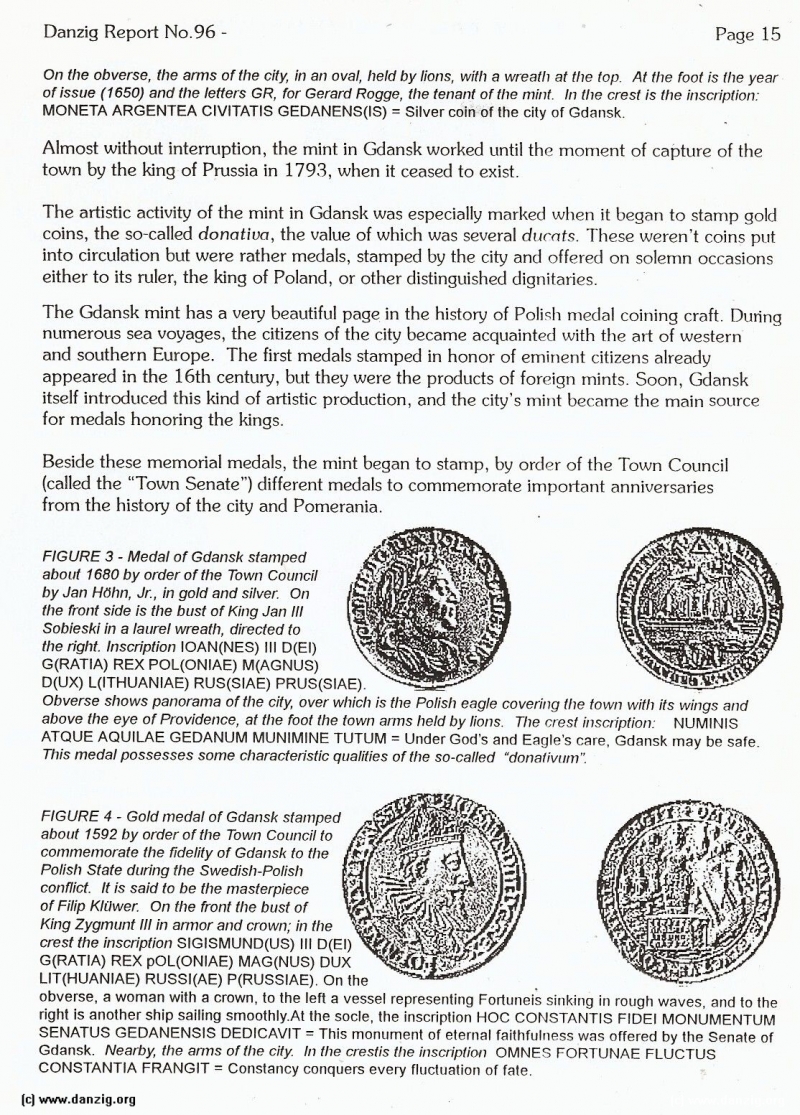
On (lie obverse, (he arms of the city, in an oval, held by lions, with a wreath at (lie top. At the foot is (lie year of issue (1650) and (he letters GR, for Gerard Rogge, the tenant of (lie mint. In the crest is the inscription: MONETA ARGENTEA CIVITATIS GEDANENS(IS) = Silver coin of the city of Gdansk.
Almost without interruption, the mint in Gdansk worked until the moment of capture of the town by the king of Prussia in 1793, when it ceased to exist.
The artistic activity of the mint in Gdansk was especially marked when it began to stamp gold coins, the so-called donativa, the value of which was several ducats. These weren’t coins put into circulation but were rather medals, stamped by the city and offered on solemn occasions either to its ruler, the king of Poland, or other distinguished dignitaries.
The Gdansk mint has a very beautiful page in the history of Polish medal coining craft. During numerous sea voyages, the citizens of the city became acquainted with the art of western and southern Europe. The first medals stamped in honor of eminent citizens already appeared in the 16th century, but they were the products of foreign mints. Soon, Gdansk itself introduced this kind of artistic production, and the city’s mint became the main source for medals honoring the kings.
Beside these memorial medals, the mint began to stamp, by order of the Town Council (called the “Town Senate”) different medals to commemorate important anniversaries from the history of the city and Pomerania.
FIGURE 3 - Medal of Gdansk stamped about 1680 by order of (lie Town Council by Jan HOhn, Jr., in gold and silver. On the front side is the bust of king Jan III Sobieski in a laurel wreath, directed to the right. Inscription IOAN(NES) lii D(El) G(RATIA) REX POL(ONIAE) M(AGNUS) D(UX) L(ITHUANIAE) RUS(SIAE) PRUS(SIAE). Obverse shows panorama of the city, over which is (he Polish eagle covering (he town with its wings and above the eye of Providence, at the foot the town arms held by lions. The crest inscription: NUMINIS ATQUE AQUILAE GEDANUM MUNIMINE TUTUM = Under God’s and Eagle’s care, Gdansk may be safe. This medal possesses some characteristic qualities of (lie so-called donativum
FIGURE 4 - Gold medal of Gdansk stamped about 1592 by order of (lie Town Council to commemorate the fidelity of Gdansk to (lie Polish State during the Swedish-Polish conflict. It is said to be (lie masterpiece of Filip KlQwer. On the front the bust of King Zygmunt Ill in armor and crown; in the crest the inscription SIGISMUND(US) Ill D(El) G(RATIA) REX pOL(ONIAE) MAG(NUS) DUX LIT(HUANIAE) RUSSI(AE) P(RUSSIAE). On the obverse, a woman with a crown, to the left a vessel representing Fortuneis sinking iii rough waves, and to the right is another ship sailing smoothly.At the socle, the inscription HOC CONSTANTIS FIDEl MONUMENTUM SENATUS GEDANENSIS DEDICAVIT This monument of eternal faithfulness was offered by the Senate of Gdansk. Nearby, the arms of (lie city. lii (lie crestis the inscription OMNES FORTUNAE FLUCTUS CONSTANTIA FRANGIT Constancy conquers every fluctuation of fate.
Danzig Report Vol. 1 - Nr. 96 - July - August - September - 1997, Page 15.
Hits: 1899
Added: 20/07/2015
Copyright: 2024 Danzig.org

